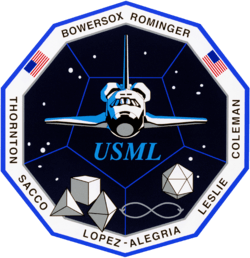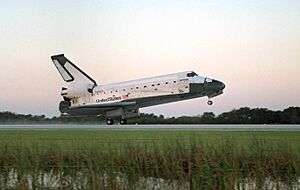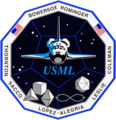STS-73 facts for kids

Spacelab Module LM1 in Columbia's payload bay, serving as the United States Microgravity Laboratory
|
|
| Mission type | Microgravity research |
|---|---|
| Operator | NASA |
| Mission duration | 15 days, 21 hours, 53 minutes, 16 seconds |
| Distance travelled | 10,600,000 kilometres (6,600,000 mi) |
| Orbits completed | 255 |
| Spacecraft properties | |
| Spacecraft | Space Shuttle Columbia |
| Payload mass | 15,250 kilograms (33,620 lb) |
| Crew | |
| Crew size | 7 |
| Members |
|
| Start of mission | |
| Launch date | 20 October 1995, 13:53:00 UTC |
| Launch site | Kennedy LC-39B |
| End of mission | |
| Landing date | 5 November 1995, 11:45:21 UTC |
| Landing site | Kennedy SLF Runway 33 |
| Orbital parameters | |
| Reference system | Geocentric |
| Regime | Low Earth |
| Perigee | 241 kilometres (150 mi) |
| Apogee | 241 kilometres (150 mi) |
| Inclination | 39.0 degrees |
| Period | 89.7 min |
  Left to right - Seated: Sacco, Rominger, Lopez-Alegria; Standing: Coleman, Bowersox, Leslie, Thornton |
|
STS-73 was a Space Shuttle mission that took place in October and November 1995. The mission used the Space Shuttle Columbia. It was the second mission for the United States Microgravity Laboratory. This special lab allowed astronauts to study how things behave in a nearly weightless environment.
The crew spent about 16 days in space. They worked in two different groups, called the "red team" and the "blue team." The mission also included many detailed tests and experiments.
Contents
Meet the STS-73 Crew
The STS-73 mission had a team of seven skilled astronauts. Each person had a special role to play during the flight.
| Position | Astronaut | |
|---|---|---|
| Commander | Kenneth D. Bowersox Third spaceflight |
|
| Pilot | Kent V. Rominger First spaceflight |
|
| Mission Specialist 1 | Catherine G. Coleman First spaceflight |
|
| Mission Specialist 2 | Michael López-Alegría First spaceflight |
|
| Mission Specialist 3 | Kathryn C. Thornton Fourth and last spaceflight |
|
| Payload Specialist 1 | Fred W. Leslie Only spaceflight |
|
| Payload Specialist 2 | Albert Sacco Jr. Only spaceflight |
|
What Was the Mission About?
The main goal of STS-73 was to carry the second United States Microgravity Laboratory (USML-2) into space. This lab was a special part of the Spacelab module. The mission lasted 16 days and was a team effort. The U.S. government, universities, and different companies worked together. They wanted to learn more about science and technology in "microgravity." This is the almost weightless feeling you get in space.
Experiments in Microgravity
Some of the experiments on USML-2 were based on what scientists learned from the first USML mission in 1992. That mission, called USML-1, also flew on the Space Shuttle Columbia. USML-1 helped scientists understand how fluids behave without gravity. It also showed how gravity affects burning and how flames spread. They also studied how gravity changes the way semiconductor crystals form. Data from protein crystals grown on USML-1 helped scientists figure out their tiny structures.
USML-2 continued this important work. Scientists used what they learned from USML-1 to make the new mission even better. They improved their equipment to understand basic physics on Earth and in space. This research also helped prepare for future space programs, like the International Space Station.
Controlling the Science from Earth
Flight controllers and scientists on Earth managed the experiments. They worked from NASA's Spacelab Mission Operations Control facility. This center is located at the Marshall Space Flight Center. Other science teams at different NASA centers and universities also helped. They watched and supported the many experiments being done.
Other Cool Payloads
Besides the main lab, STS-73 carried other cool equipment. These included:
- The Orbital Acceleration Research Experiment (OARE)
- The Space Acceleration Measurement System (SAMS)
- The Three Dimensional Microgravity Accelerometer (3DMA)
- The Suppression of Transient Accelerations By Levitation Evaluation (STABLE)
- The High-Packed Digital Television Technical Demonstration system
Some of the STS-73 crew members even appeared on a TV show! They were on an episode of Home Improvement in February 1996.
Launch Challenges
The launch of STS-73 was planned for September 25, 1995. However, it faced many delays. The launch was called off six times before it finally lifted off on October 20, 1995. STS-73 and another mission, STS-61C, hold the record for the most launch delays. Both missions launched on their seventh attempt.
Images for kids
See also
 In Spanish: STS-73 para niños
In Spanish: STS-73 para niños








